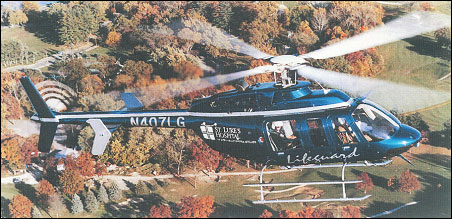
| Bell Model 407 1984 |  |
 |

| Bell Model 407 1984 |  |
 |
|
Design definition launched in 1993 as Bell Light Helicopter to supplement, and eventually replace, JetRanger and LongRanger; concept demonstrator Model 407 (N407LR) first flown 21 April 1994 (standard Bell 206L-3 modified with tailboom and dynamic system of military OH-58D, plus sidewall fairings to simulate broader fuselage); programme first revealed at Heli-Expo '95, Las Vegas, January 1995. Two prototype/ pre-production 407s (C-GFOS and C-FORS) first flown on 29 June and 13 July 1995, respectively; first producrion airframe (C-FWQY/N407BT) flown 10 November 1995. Transport Canada certification 9 February 1996 with FAA certification following on 23 February; first customer delivery at Heli-Expo '96, Dallas, in February, MoU of June 1996 provided for licensed assembly and marketing by Dirgantara (formerly IPTN) of Indonesia. Law Enforcement Demonstrator being promoted from 2002 features bubble windows, NightSun searchlights and FLIR, equipped by Edwards and Associates of Bristol, Tennessee. CUSTOMERS: Launch customers Petroleum Helicopters, Niagara Helicopters and Greenland Air. The 500th production Bell 407 was delivered in October 2001 to Pabst Air, Germany; some 550 delivered to operators in 45 countries by early 2003; fleet time then totalled more than 745,000 hours. Law enforcement operators include Tampa Police Department, Florida; Palm Beach County Sheriff's Office; and the State Police Departments of Connecticut, Louisiana, New York and Virginia. Recent customers include the Los Angeles Department of Water and Power, which ordered two in October 2002, to supplement and eventually replace, LongRangers, and Med-Trans Corporation of Bismark, North Dakota, which ordered five for delivery in 2003 to supplement 14 Bell 407s and two JetRangers already in service. Total of 62 delivered in 1999, 62 in 2000, 47 in 2001 and 33 in 2002. COSTS: US$1.37 million (1999) flyaway. Average direct operating cost US$307 per hour (1999). Development cost estimated as US$50 million, of which US$9 million provided by Canadian government. DESIGN FEATURES: As for JetRanger and LongRanger. Based on Bell 206L-4 LongRanger fuselage with cabin widened by 17.8cm; 35% larger cabin window area; Litton LCD active matrix cockpit displays; all-composites four-blade main rotor based on that of OH-58D, with soft-mounted pylon isolation system, single Rolls-Royce 250-C47 turboshaft; enlarged vertical stabilisers. 'Ring-fin' shrouded rotor tested in 1995 as possible future option. Rotor speed 413rpm. STRUCTURE: Generally as for LongRanger, but with carbon fibre tailboom and flush-fitting cabin door windows and skylights. LANDING GEAR: LongRanger unit modified to match new rotor's ground-resonance characteristics, and with rear cross-tube pivoted in centre between outboard damping pads. High skids, low skid fairings and pop-out floats, optional. POWER PLANT: One Rolls-Royce 250-C47B turboshaft rated at 606kW for T-O, 523kW maximum continuous; transmission rating 503kW for T-O. 470kW continuous operation. Single-channel FADEC standard. Standard usable fuel capacity 484 litres; optional auxiliary fuel tank in aft baggage compartment, usable capacity 72 litres; oil capacity 5.7 litres. 'Quiet Cruise' system, in development in early 1997, reduces flyover noise level by using FADEC to reduce rotor rpm to 90 to 93 per cent in the cruise, with accompanying reduction in Vne to 204km/h. ACCOMODATION: With a crew of two, standard cabin layout accommodates five passengers in two rearward-facing seats with centre armrest/console, and three forward-facing seats, all fabric-covered. Optional utility cabin has vinyl-covered seats; corporate interior features two extra-wide forward-facing seats in the outboard positions, an occasional-use seat in the centre and additional soundproofing. SYSTEMS: Electrical system, includes 28V 17Ah Ni/Cd battery and 180A starter generator. AVIONICS: Bendix/King suite options to customers choice include KX 155 and KX 165 nav/com, KY 196A VHF, KT 70 and KY 76A transponder, KR 87 ADF, KLN 89B GPS, KCS 55A compass system and ELT. Jane's All the World's Aircraft, 2004-2005
Bell 206L Long Ranger with composite 4-blade main rotor, bulged cabin transparencies and FADEC fuel control system. R.Simpson "Airlife's Helicopter and Rotorcraft", 1998
|